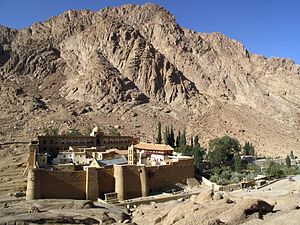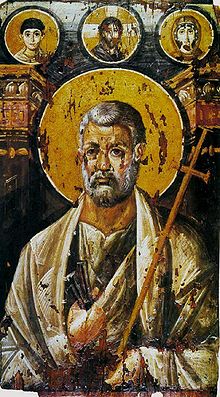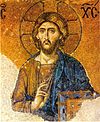- Saint Catherine's Monastery, Mount Sinai
-
Saint Catherine Area * UNESCO World Heritage Site
Country Egypt Type Cultural Criteria i, iii, iv, vi Reference 954 Region ** Arab States Inscription history Inscription 2002 (26th Session) * Name as inscribed on World Heritage List
** Region as classified by UNESCOSaint Catherine's Monastery (Greek: Μονὴ τῆς Ἁγίας Αἰκατερίνης Moni tes Hagias Aikaterines) lies on the Sinai Peninsula, at the mouth of a gorge at the foot of Mount Sinai in the city of Saint Catherine in Egypt's South Sinai Governorate. The monastery is Orthodox and is a UNESCO World Heritage Site. According to the UNESCO report (60100 ha / Ref: 954), this monastery is one of the oldest working Christian monasteries in the world together with the Monastery of Saint Anthony, situated across the Red Sea in the desert south of Cairo, which also lays claim to that title.
Contents
History
 St. Catherine's Monastery possesses some of the earliest icons in existence, including this 6th-century hot wax icon.
St. Catherine's Monastery possesses some of the earliest icons in existence, including this 6th-century hot wax icon.
The oldest record of monastic life at Sinai comes from the travel journal written in Latin by a woman named Egeria about 381-384. She visited many places around the Holy Land and Mount Sinai, where, according to the Hebrew Bible, Moses received the Ten Commandments from God.[1]
The monastery was built by order of Emperor Justinian I (reigned 527-565), enclosing the Chapel of the Burning Bush ordered to be built by Helena, the mother of Constantine I, at the site where Moses is supposed to have seen the burning bush; the living bush on the grounds is purportedly the original. It is also referred to as "St. Helen's Chapel." The site is sacred to Judaism, Christianity and Islam.
Though it is commonly known as Saint Catherine's, the full, official name of the monastery is, The Sacred and Imperial Monastery of the God-Trodden Mount of Sinai, and the patronal feast of the monastery is the Transfiguration. The site was associated with Saint Catherine of Alexandria (whose relics were purported to have been miraculously transported there by angels) and it became a favorite site of pilgrimage.
 Saint Catherine's monastery, photographed by Leavitt Hunt, first American to photograph the Middle East, 1852, George Eastman House
Saint Catherine's monastery, photographed by Leavitt Hunt, first American to photograph the Middle East, 1852, George Eastman House
According to tradition, Catherine of Alexandria was a Christian martyr initially sentenced to death on the wheel. However, when this failed to kill her, she was beheaded. According to tradition, angels took her remains to Mount Sinai. Around the year 800, monks from the Sinai Monastery found her remains.
The monastery possesses copies of an important historical document, the Achtiname, in which Muhammad is claimed to have bestowed his protection upon the monastery.[2]
A Fatimid mosque was built within the walls of the monastery, but it has never been used since it is not correctly oriented towards Mecca.
During the seventh century, the isolated Christian anchorites of the Sinai were eliminated: only the fortified monastery remained. The monastery is still surrounded by the massive fortifications that have preserved it. Until the twentieth century, access was through a door high in the outer walls. From the time of the First Crusade, the presence of Crusaders in the Sinai until 1270 spurred the interest of European Christians and increased the number of intrepid pilgrims who visited the monastery. The monastery was supported by its dependencies in Egypt, Palestine, Syria, Crete, Cyprus and Constantinople.
The monastery is depicted as a scene on the back panel of the Modena Triptych by El Greco.
It is seen in the PBS documentary, Walking the Bible with Bruce Feiler.
About the monastery
The monastery library preserves the second largest collection of early codices and manuscripts in the world, outnumbered only by the Vatican Library. Its strength lies in Greek, Arabic, Armenian, Hebrew, Georgian, Syriac and old Udi texts. The Codex Sinaiticus, now in the British Library, left the monastery in the 19th century for Russia, in circumstances that are now disputed.[3]
A panorama of St Catherine's
The complex houses irreplaceable works of art: mosaics, the best collection of early icons in the world, many in encaustic, as well as liturgical objects, chalices and reliquaries, and church buildings. The large icon collection begins with a few dating to the 5th (possibly) and 6th centuries, which are unique survivals, the monastery having been untouched by Byzantine iconoclasm, and never sacked. The oldest icon on an Old Testament theme is also preserved there. A project to catalogue the collections has been ongoing since the 1960s.
The monastery, along with several dependencies in the area, constitute the entire Orthodox Church of Mount Sinai, which is headed by an archbishop, who is also the abbot of the monastery. The exact administrative status of the church within Eastern Orthodoxy is ambiguous: by some, including the church itself,[4] it is considered autocephalous,[5][6] by others an autonomous church under the jurisdiction of the Greek Orthodox Church of Jerusalem.[7][dead link] The archbishop is traditionally consecrated by the Orthodox Patriarch of Jerusalem; in recent centuries he has usually resided in Cairo. During the period of the Crusades, marked by bitterness between the Orthodox and Catholic churches, the monastery was patronized by both the Byzantine Emperors and the rulers of the Kingdom of Jerusalem, and their respective elites. The monastery was an important centre for the development of the hybrid style of Crusader art, and still retains over 120 icons created in the style, by far the largest collection in existence. Many were evidently created by Latins, probably monks, based in or around the monastery in the 13th century.[8] Prior to September 1, 2009, a previously unseen fragment of Codex Sinaiticus was discovered in the monastery's library.[9]
Coordinates: 28°33′20″N 33°58′34″E / 28.55556°N 33.97611°E
Gallery of art at Saint Catherine's
-
The oldest known icon of Christ Pantocrator, encaustic on panel
-
Emperor John VIII Palaiologos
-
Icon of Saint Catherine of Alexandria
See also
- Saint Catherine, Egypt
- Apology of Aristides
- Archbishop of Mount Sinai and Raithu
- Greek Orthodox Church
- Charnel House
- Christ Pantocrator
- Codex Sinaiticus
- Eastern Christianity
- Gregory of Sinai
- Hermit
- Ladder of Divine Ascent
- Macarius of Egypt
- Mary of Egypt
- Monastery of Saint Anthony, the oldest monastery
- Oldest churches in the world
- Poustinia
- Saint John Climacus
- Sümela Monastery
- Syriac Sinaiticus
- Kurt Weitzmann
References
- ^ Pilgrimage of Etheria text at ccel.org
- ^ Brandie Ratliff, "The monastery of Saint Catherine at Mount Sinai and the Christian communities of the Caliphate." Sinaiticus. The bulletin of the Saint Catherine Foundation (2008).
- ^ "Oldest known Bible to go online". BBC News, 3 August 2005.
- ^ The official Website describes the Church as "διοικητικά "αδούλωτος, ασύδοτος, ακαταπάτητος, πάντη και παντός ελευθέρα, αυτοκέφαλος" or "administratively 'free, loose, untresspassable, free from anyone at any time, autocephalous'" (see link below)
- ^ Weitzmann, Kurt, in: Galey, John; Sinai and the Monastery of St. Catherine, p. 14, Doubleday, New York (1980) ISBN 0385171102
- ^ Ware, Kallistos (Timothy) (1964). "Part I: History". The Orthodox Church. Penguin Books. http://www.fatheralexander.org/booklets/english/history_timothy_ware_1.htm. Retrieved 2007-07-14. Under Introduction Bishop Kallistos says that Sinai is "autocephalous"; under The twentieth century, Greeks and Arabs he states that "There is some disagreement about whether the monastery should be termed an 'autocephalous' or merely an 'autonomous' Church."
- ^ The Orthodox Church of Mount Sinai CNEWA Canada, "A papal agency for humanitarian and pastoral support"
- ^ Kurt Weitzmann in The Icon, Evans Brothers Ltd, London (1982), pp. 201-207 (trans. of Le Icone, Montadori 1981), ISBN 0237456451
- ^ "Fragment from world's oldest Bible found hidden in Egyptian monastery". The Independent, 2 Sept, 2009.
Further reading
- Forsyth, G. H.; Weitzmann, K. (1973). The Monastery of Saint Catherine at Mount Sinai - The Church and Fortress of Justinian: Plates. Princeton: Princeton University Press. ISBN 0472330004.
- Sotiriou, G. and M. (1956-8). Icones du Mont Sinaï. 2 vols (plates and texts). Collection de L'Institut francais d'Athènes 100 and 102. Athens.
- Weitzmann, K. (1976). The Monastery of Saint Catherine at Mihnt Sinai: The Icons, Volume I: From the Sixth to the Tenth Century. Princeton: Princeton University Press.
- Weitzmann, K.; Galavaris, G. (1991). The Monastery of Saint Catherine at Mount Sinai. The Illuminated Greek Manuscripts, Volume I. From the Ninth to the Twelfth Century. Princeton: Princeton University Press. ISBN 0-691-03602-0.
External links
- Saint Catherine Area World Heritage Listing on UNESCO's Website
- Official Website of the Holy Monastery of St. Catherine at Mount Sinai
- Chapel of St. Helen
- St. Catherine's Monastery, Sinai, Egypt
- Camberwell/St.Catherine's Project
- Holy Image, Hallowed Ground: Icons from Sinai Getty exhibit
- Early Icons from Sinai, Belmont U
- St. Catherine's Monastery (Sinai) (OrthodoxWiki article)
- The text of the Charter from Muhammad can be read here or here.
- At a Mountain Monastery, Old Texts Gain Digital Life article from New York Times
- Information about the town of St. Catherine
- The Physical Components of the Monastery
- The Icons of St. Catherine's—Gallery
- Gallery of Artifacts in the Monastery's Collection
 "Monastery of Saint Catherine". Catholic Encyclopedia. New York: Robert Appleton Company. 1913.
"Monastery of Saint Catherine". Catholic Encyclopedia. New York: Robert Appleton Company. 1913.- Prophet Muhammad's Letter to Monks of St. Catharine Monastery
- More on Saint Catherine's Monastery and Mount Sinai
Upper Egypt: 
Middle Egypt: Monastery of Saint ParsomaLower Egypt: Eastern Desert: Scetes: Monastery of Saint Macarius the Great · Monastery of Saint Pishoy · Paromeos Monastery · Syrian MonasterySinai: Monastery of Saint CatherineCategory – Christianity in Egypt – Monasteries by countryAutocephalous and Autonomous Churches of Eastern Orthodoxy Autocephalous Churches Four Ancient Patriarchates: Constantinople · Alexandria · Antioch · Jerusalem
Russia · Serbia · Romania · Bulgaria · Georgia · Cyprus · Greece · Poland · Albania · Czech Republic and Slovakia · America* · Macedonia*Autonomous Churches * Autocephaly or autonomy is not universally recognized.
** Semi-autonomous part of the Russian Orthodox Church whose autonomy is not universally recognized.Greek Orthodox Christianity Patriarchates 
Autocephalous and
Autonomous churchesChurch of Greece | Church of Cyprus | Orthodox Autocephalous Church of Albania | Saint Catherine's Monastery, Mount SinaiEparchies Greek Orthodox Archdiocese of Thyateira and Great Britain | Greek Orthodox Archdiocese of Italy and Exarchate of Southern Europe | Greek Orthodox Archdiocese of America | Greek Orthodox Archdiocese of AustraliaWorld Heritage Sites in Egypt Abu Mena · Islamic Cairo · Memphis and its Necropolis – the Pyramid Fields from Giza to Dahshur · Nubian Monuments from Abu Simbel to Philae · Saint Catherine Area · Ancient Thebes with its Necropolis · Wadi Al-Hitan (Whale Valley)
Categories:- World Heritage Sites in Egypt
- 560s architecture
- Archives in Egypt
- Byzantine sacred architecture
- Hesychasm
- Christian monasteries in Egypt
- Greek Orthodox monasteries
- Sinai Peninsula
- Eastern Orthodox church buildings
- Eastern Orthodox church bodies and patriarchates in Asia
- Christian monasteries established in the 6th century
- Archaeological sites in Egypt
Wikimedia Foundation. 2010.








